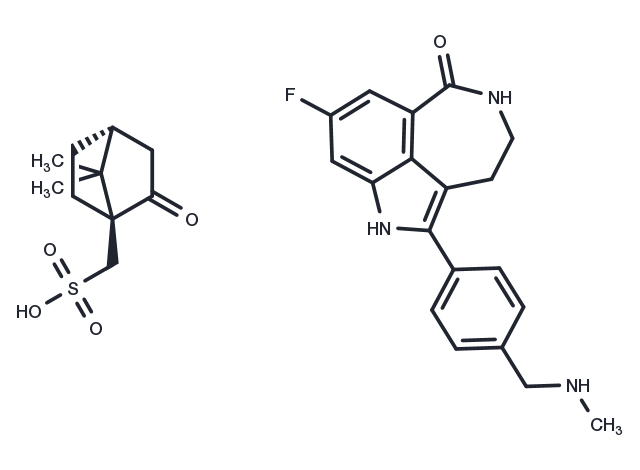Powder: -20°C for 3 years | In solvent: -80°C for 1 year


Rucaparib monocamsylate (Rucaparib Camsylate) is a PARP inhibitor (PARP1,Ki of 1.4 nM). Rucaparib Camsylate also displays binding affinity to eight other PARP domains.

| Pack Size | Availability | Price/USD | Quantity |
|---|---|---|---|
| 5 mg | In stock | $ 55.00 | |
| 10 mg | In stock | $ 97.00 | |
| 25 mg | In stock | $ 163.00 | |
| 50 mg | In stock | $ 247.00 | |
| 100 mg | In stock | $ 372.00 | |
| 200 mg | In stock | $ 549.00 | |
| 1 mL * 10 mM (in DMSO) | In stock | $ 68.00 |


| Description | Rucaparib monocamsylate (Rucaparib Camsylate) is a PARP inhibitor (PARP1,Ki of 1.4 nM). Rucaparib Camsylate also displays binding affinity to eight other PARP domains. |
| Targets&IC50 | PARP1:1.4 nM (Ki) |
| In vitro | Rucaparib is the most effective PARP inhibitor in enzyme assays (Ki: 1.4 nM). Rucaparib inhibits PARP-1 activity by 97.1% at a concentration of 1 μM in permeabilized D283Med cells. Rucaparib could target NF-κB activated by DNA damage and overcome toxicity observed with classical NF-κB inhibitors without compromising other vital inflammatory functions. The radio-sensitization by Rucaparib is due to downstream inhibition of activation of NF-κB and is independent of SSB repair inhibition [1][2][3]. |
| In vivo | Rucaparib is not toxic but obviously enhances temozolomide-induced TGD in the DNA repair protein-competent D384Med xenografts. Rucaparib and AG14584 obviously (P < 0.05) increase temozolomide toxicity. Rucaparib enhances the antitumor activity of temozolomide and indicates complete and sustained tumor regression in NB1691 and SHSY5Y xenografts. Rucaparib significantly potentiates the cytotoxicity of topotecan and temozolomide in NB-1691, SH-SY-5Y, and SKNBE (2c) cells. Rucaparib (1 mg/kg) significantly increases temozolomide-induced body weight loss. Rucaparib (0.1 mg/kg) results in a 50% increase in the temozolomide-induced tumor growth delay. Pharmacokinetics studies also show that Rucaparib is detected in the brain tissue, which indicates that Rucaparib has potential in intra-cranial malignancy therapy [1][3][4]. |
| Synonyms | Rucaparib Camsylate |
| Molecular Weight | 555.66 |
| Formula | C29H34FN3O5S |
| CAS No. | 1859053-21-6 |
Powder: -20°C for 3 years | In solvent: -80°C for 1 year
DMSO: 82.33 mg/mL(148.17 mM)
You can also refer to dose conversion for different animals. More
bottom
Please see Inhibitor Handling Instructions for more frequently ask questions. Topics include: how to prepare stock solutions, how to store products, and cautions on cell-based assays & animal experiments, etc.
Rucaparib monocamsylate 1859053-21-6 Chromatin/Epigenetic DNA Damage/DNA Repair PARP repair H6PD BRCA1 poly ADP ribose polymerase AG14644 SSB PF-01367338 monocamsylate Capan-1 Inhibitor AG014699 monocamsylate NF-κB inhibit MX-1 BRCA2 Rucaparib Camsylate inhibitor
